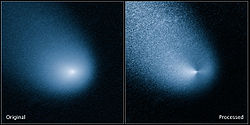C/2013 A1
| C/2013 A1 (Siding Spring) | |
 C/2013 A1 sedd av Hubble (11 mars 2014). | |
| Upptäckt | |
|---|---|
| Upptäckare | Siding Spring-observatoriet |
| Upptäcktsdatum | 3 januari 2013 |
| Beteckningar | |
| MPC-beteckning | C/2013 A1 |
| Alternativnamn | Komet Siding Spring |
| Omloppsbana | |
| Epok: 6 januari 2013 | |
| Perihelium | 1,396 AU |
| Excentricitet | 1,00038 |
| Inklination | 128,9° |
| Nästa perihelium | 25 oktober 2014 |
C/2013 A1 (Siding Spring) är en komet från Oorts kometmoln som upptäcktes 3 januari 2013 av Robert H. McNaught vid Siding Spring-observatoriet.[1] Den 19 oktober 2014 passerade kometen planeten Mars på endast 140 000 km avstånd. Hastigheten vid passagen var ungefär 56 km/s.
Spekulationer om kollision med Mars
Med ledning av fotografier från tiden före upptäckt (december 2012) och observationer i februari 2013 av Leonid Elenin beräknades att kometen skulle komma att passera så nära Mars som 0,000276 AU (41 300 km). 3 mars 2013 hittades foton vid Pan-STARRS-observatoriet från 4 oktober 2012, vilket gjorde att observationstiden kunde utökas till 148 dagar.[2] Vid upptäckten befann sig kometen 7,2 AU från solen i stjärnbilden Haren.
Kometen passerade mycket nära Mars den 19 oktober 2014. Det fanns till och med en liten möjlighet att den skulle kollidera med planeten. Med en observationstid på 148 dagar beräknades kometen passera på ett avstånd av 0,00035 AU (52 000 km) från planetens centrum. Osäkerheten i beräkningarna var så pass stora att kometen också kunde passera på ett avstånd av 0,0021 AU (310 000 km).
Kometkärnans storlek beräknades vara mer än 3 km, men mindre än 50 km. Det senare skulle motsvara en kraft vid en kollision på 20 miljarder megaton TNT. Med Monte Carlo-metoden beräknades kollisionsrisken till 1/1250 eller 0,08 procent.[3]
Observationer vid passagen
Den 19 oktober 2014 var planeten Mars i Ormbärarens stjärnbild, 60 grader från solen. Mars och kometen kunde observeras från satelliten STEREO-A under passagen. Den amerikanska rymdfarkosten MAVEN som ska utforska Mars atmosfär kommer också just att ha anlänt till planeten och bidra till observationerna.
Dessutom finns samtidigt det svenska instrumentet ASPERA-3 ombord på den europeiska satelliten Mars Express på plats vid Mars för att göra mätningar.[4]
Källor
- ^ Minor Planet Center. ”MPEC 2013-A14”. https://www.minorplanetcenter.net/mpec/K13/K13A14.html. Läst 6 mars 2013.
- ^ Minor Planet Center. ”C/2013 A1 (Siding Spring)”. https://www.minorplanetcenter.net/db_search/show_object?object_id=CK13A010. Läst 6 mars 2013.
- ^ SpaceObs.Org. ”Probability of Collision with Mars - 0,08 %”. Arkiverad från originalet den 7 mars 2013. https://web.archive.org/web/20130307081417/http://spaceobs.org/en/2013/03/03/probability-of-collision-with-mars/. Läst 6 mars 2013.
- ^ Svenskt instrument gör mätningar när en komet passerar Mars Arkiverad 24 september 2015 hämtat från the Wayback Machine., IRF pressmeddelande (2014-10-15).
Media som används på denna webbplats
March 27, 2014
RELEASE 14-090
NASA's Hubble Space Telescope Spots Mars-Bound Comet Sprout Multiple Jets
Comet C/2013 A1 as seen by NASA's Hubble Space Telescope The images above show -- before and after filtering -- comet C/2013 A1, also known as Siding Spring, as captured by Wide Field Camera 3 on NASA's Hubble Space Telescope.
NASA released Thursday an image of a comet that, on Oct. 19, will pass within 84,000 miles of Mars -- one third the distance between Earth and our moon.
The image on the left, captured March 11 by NASA's Hubble Space Telescope, shows comet C/2013 A1, also called Siding Spring, at a distance of 353 million miles from Earth. Hubble can't see Siding Spring's icy nucleus because of its diminutive size. The nucleus is surrounded by a glowing dust cloud, or COMA, that measures roughly 12,000 miles across.
The right image shows the comet after image processing techniques were applied to remove the hazy glow of the coma revealing what appear to be two jets of dust coming off the location of the nucleus in opposite directions. This observation should allow astronomers to measure the direction of the nucleus’s pole, and axis of rotation.
Hubble also observed Siding Spring on Jan. 21 as Earth was crossing its orbital plane, which is the path the comet takes as it orbits the sun. This positioning of the two bodies allowed astronomers to determine the speed of the dust coming off the nucleus.
"This is critical information that we need to determine whether, and to what degree, dust grains in the coma of the comet will impact Mars and spacecraft in the vicinity of Mars," said Jian-Yang Li of the Planetary Science Institute in Tucson, Arizona.
Discovered in January 2013 by Robert H. McNaught at Siding Spring Observatory, the comet is falling toward the sun along a roughly 1 million year orbit and is now within the radius of Jupiter's orbit. The comet will make its closest approach to our sun on Oct. 25, at a distance of 130 million miles – well outside of Earth's orbit. The comet is not expected to become bright enough to be seen by the naked eye.
The Hubble Space Telescope is a project of international cooperation between NASA and the European Space Agency. NASA's Goddard Space Flight Center in Greenbelt, Md., manages the telescope. The Space Telescope Science Institute (STScI) in Baltimore conducts Hubble science operations. STScI is operated for NASA by the Association of Universities for Research in Astronomy, Inc., in Washington.
For images and more information about Hubble, visit:
http://www.nasa.gov/hubble